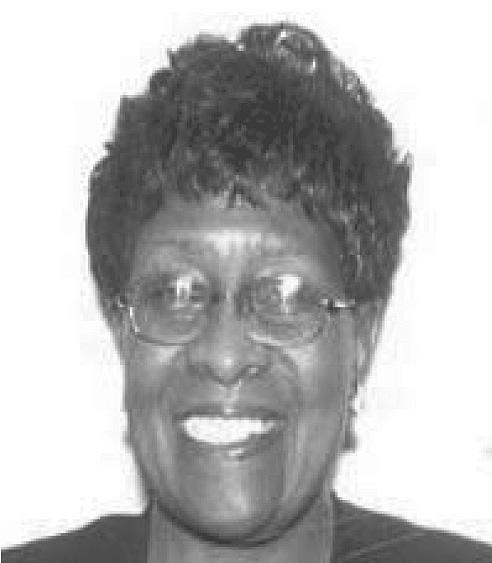
12 minute read
Engage in spring cleaning, clear that
from Vol 82 - No 6
March 20, 2020 LIFE & STYLE/HEALTH & WELLNESS THE OMAHA STAR Page Seven By Sheila Fields Our current climate has changed how we do things daily. ‘Getting it done’ has taken on a whole new meaning. Because of our new normal, it is easy to feel frustrated and bored. We’ve been presented with an opportunity to challenge how we view our present state, get things done, and avoid the trap of becoming unproductive. Why Do You Feel Bored? • Plans have changed – Abrupt schedule changes can be frustrating. It’s important to remain flexible and seize the opportunity to take care of things within your control.
• Putting things off – What have you been procrastinating to get done? Look at your to-do list and go to work on unfinished tasks. If you don’t have a to-do list, now’s the time to create one! • Lack of inspiration – Reflect on your vision or purpose to remember why you need to get busy and stay motivated. If you don’t have one, take a stab at it. Creating a vision board provides a great visual reminder of what’s important. • Logistics – Our environment may change, but we can still have impact. As we get used to standing in lines, working in our homes, or patiently waiting for products or services, remember that we can work on small tasks, check on friends or just use the time for reflection. Here are a few additional strategies to attack boredom:
• Accountability Partners – Grab trusted friends or colleagues that are willing to hold you accountable. Schedule a regular touch base to provide honest updates. • MITs - Create a list of your most important tasks. These are the things that have the biggest impact. Complete the first and early in the day. • Mini breaks – Tackle tiny tasks to break the monotony. Small tasks matter such as a quick call to check on a neighbor, reading an educational article or motivational piece, or simply organizing your workspace.
• Use your timer for productivity bursts – For an allocated amount of time (e.g. 15 minutes) completely focus on the task at hand. Pause and repeat!
• Limit time for low value activities – Schedule a limited timeframe for low value activities such as television, surfing the web, or social media. These can be time stealers that kept us from getting important tasks done. • Learn something new – Downtime is a great opportunity to learn something new. This is an opportunity to complete a new degree or certification, learn how to do repairs and home improvements, o r learn a new craft.
• Volunteer or Support Someone – The greatest way to get through tough times is to help support others. Checking on an elderly person, volunteering to pick up items for them, or helping a child with homework (virtually) could be priceless to someone else. • Journal – Write your thoughts an d experiences. It will be a great way to tell about this interesting journey and reflec t on how you’ve grown through this experience. As we are blessed with a new challenge in how we manage our life, remember tha t boredom is a state of mind. Our mind is also where success begins. With that in mind, try these strategies to avoid monotony and stay focused on results. Life Coach’s Corner - You’re Bored. Now what?
Social Distancing Tips
Practicing social distancing to mitigate the COVID-19 pandemic may sound scary or impossible to do, but there are ways to appropriately handle the process, says Jagdish Khubchandani, a health science professor at Ball State University. The Centers for Disease Control and Prevention has issued guidelines to limit the spread of COVID-19 that include recommendations for social distancing – a term epidemiologists use to refer to a conscious effort to reduce close contact between people and hopefully stymie community transmission of the virus. “Social distancing can be tough on people and disrupt the social and economic fibers of our society,” Khubchandani said. “Given the existing crisis of isolation in societies – with probably the loneliest young generation that we have today – social distancing can also take a personal health toll on people, causing psychological problems, among many others.” Khubchandani recommended 15 ways to counterbalance the effects of social distancing: 1. Maintain a routine. As much as possible, social distancing should not disrupt your sleep-wake cycle, working hours, and daily activities. 2. Make social distancing a positive by taking the time to focus on your personality and personal health, reassessing your work, training, diet patterns, physical activity levels, and health habits. 3. Carve time to cook for yourself and others in need. Add more fruits, vegetable, vitamins, and proteins to your diet (most adults in the United States do not consume enough fruits and vegetables). Get 2-3 meals a day. 4. Go for a walk or exercise at home. Definitely go out in nature as much as possible. Only half of American adults today get enough exercise. 5. Do not let anxiety or being at home lead you to indulge in binge eating or alcohol and drug use. Don’t oversleep, but do sleep at least 7 hours. Our recent study found that more than a third of Americans sleep less than 7 hours. 6. Social distancing can cause anxiety and depression due to disruption of routines, isolation, and fear due to a pandemic. If you or someone you know is struggling, there are ways to get help from a distance. 7. Think forward and try to make best use of technology to finish your work, attend meetings, and engage with coworkers with the same frequency that is required during active office hours. The good news: Working from home can make people more productive and happier. 8. Small breaks due to social distancing are also times to reassess your skill and training- think of an online course, certification, training, personality development, or new language to learn. 9. Engage in spring cleaning, clear that clutter, and donate non-junk household stuff. Household clutter can harbor infections, pollutants, and create unhygienic spaces. 10. Social distancing should not translate to an unhealthy life on social media. While you can certainly become a victim of myths, misinformation, anxiety, and fear mongering, you may also inadvertently become a perpetrator, creating more trouble for communities. 11. Based on American Time Use Survey and leisure related time-spending patterns worldwide, we spend too much time on screen. Except for 1-2 times day to watch national news for general consumption and local news to check spread of COVID19 in your own community, you are likely over-consuming information and taking away time from yourself and friends and family. 12. Reach out to people and offer help. Social distancing should also help reinvest in and recreate social bonds. Consider providing for and helping those at risk or marginalized (e.g. the elderly, disabled, and homeless; survivors of natural disasters; and those living in shelters). You will certainly find someone in the neighborhood who needs some help, this can be done from a distance, on phone, or by online activities and giving. 13. Check your list of contacts on email and phone. Certainly, there are people you have not talked to in a while – time to check on their wellbeing and connect. This will also help you feel more connected, social, healthier, and engaged. Be kind to all; you never know who is struggling and how you can make a difference. 14. Engage in alternative activities to keep your mind and body active such as: listening to music and singing, trying dancing or biking, yoga or meditation, taking virtual tours of museums and places of interest, sketching and painting, reading books or novels, solving puzzles or engaging in board games, trying new recipes and learning about other cultures, etc. 15. Do not isolate yourself totally (physical distancing should not become social isolation). Don’t be afraid, don’t panic, and do keep communicating with others.
Efo - Modified: Spinach with a Touch of Cabbage
This Efo is an easy Nigerian influenced side dish and comes packed with a major wallop of flavor. Locally, Nigerian spinach called Efo Shoko, literally translated as “Lagos Spinach”, but here, local spinach will suffice nicely! Efo is a favorite Yoruba staple tha t is so well beloved. This dish can be adapted to appeal to both vegetarians and meat eaters, without losing its rich depth of flavor either way. In this recipe is vegan, but feel free to add the meat or seafood.
½ Head of Cabbage 2 Red Peppers 32 oz Spinach 2 Tablespoons Olive Oil 1 Medium Vidalia Onion ½ Tablespoons Berbere Seasoning 2 Roma Tomatoes, Seeded Salt & White Pepper to Taste 1 Green Pepper ¼ Cup Vegetarian Broth or Water
VNA Takes Steps to Prepare for COVID-19 At the Visiting Nurse Association (VNA), the health and safety of our patients and staff are the highest priority. As cases of COVID-19 are confirmed in the area, VNA is taking steps to ensure our staff and patients are informed and protected. Regular hand washing and the use of hand sanitizer has always been a required part of our care routine. We will continue to be extra vigilant as more cases of COVID-19 could develop in the Omaha metro. Patients and nurses must wash their hands or use hand sanitizer before any treatment is provided. VNA staff who exhibit any symptoms or are exposed to someone with a fever, cough, shortness of breath or difficulty breathing are being told to stay home. The following precautions were implemented immediately in response to COVID-19 in our community: • VNA nurses are conducting a respiratory and travel screening process prior to each patient visit. Once given the all-clear, care will proceed as normal. • VNA has established a phone number for infection control and prevention needs. The number is 402-681-0228. • Nurses are determining, on a case-by-case basis, if masks, gowns or other precautions are needed to care for patients. • If a patient is exhibiting COVID-19 symptoms, treatment options will be evaluated. In some cases, VNA will utilize telehealth – an opportunity for patients to speak directly with their nurse via phone, laptop or smartphone. In the midst of an uncertain situation, VNA also recognizes the opportunity to provide a solution for those impacted by COVID-19. If cases of the virus increase in our area, many hospitalized individuals will have a need for home healthcare services after discharge. The very nature of the COVID-19 virus encourages social distancing, limiting exposure and preventing spread among people in community settings. “With an educated and protected workforce, VNA can provide significant services to those in need,” said James Summerfelt, VNA President & CEO. “Our staff is a tremendous resource in our community and we are doing everything possible to educate and protect them,” said VNA Infection Prevention Specialist, Judy Riggert. As a reminder, if you or someone you know develops a fever greater than 100.4F, cough, shortness of breath or difficulty breathing, please contact your healthcare provider or the Douglas County Health Department during office hours at 402-444-7214 or after hours at 402-444-7000. Sauté cabbage in a pot with olive oil over medium heat. Once cabbage is wilted, ad d red and green peppers, onion, garlic and Roma tomatoes. While stirring, add spinach, seasonings, and broth or water. Cover the pot, turn off heat, and allow to steam until all veggies are wilted, serve.
How Dental Technology Helps Athletes Get Back In The Game Playing a physically-demanding sport can exact a steep toll on athletes. It may even cost them their teeth. The National Youth Sports Safety Foundation estimates that, on average, 3 million teeth are knocked out every year during organized sporting events. While dentists advise athletes to wear mouthguards in most sports, the data indicates many do not. High-contact athletic competitions such as ice hockey, football, basketball, lacrosse, mixed martial arts and extreme sports (skateboarding, snowboarding, mountain biking) see athletes pay the price with their pearly whites, leading to costly trips to the dentist. Dental implants, bridges or dentures are options for replacing missing teeth after a sports injury. Another alternative is Utratooth, the only FDA-cleared immediate-load dental device, which can replace a missing tooth in just a one-hour appointment. Whichever option an athlete chooses to fill the missing gap in their mouth, advancements in dentistry can make an athlete’s return to competition and oral health a smoother process. “Injuries are a part of sports and injuries in and around the mouth are very common,” says Dr. Sargon Lazarof (www.sargondental.com), the creator of Ultratooth and a cosmetic dentist in the Los Angeles area. “The first question to be addressed is, what is the correct immediate and definitive treatment? Oralfacial injuries, those involving trauma to the mouth and face, can have significant negative functional, esthetic, and psychological effects on athletes. “Only fairly recently has greater attention focused on this critical but often overlooked segment of sports-related injuries. Oral-facial injuries can be debilitating and costly, so it’s important to consult with a dentist for the best option given the type of injury.” Dr. Lazarof explains how tooth-replacement technology benefits athletes in the short- and long-term: • Puts them back in the game quickly. According to the American Dental Association, anywhere from 13 to 39 percent of all dental injuries are sports-related. Athletes want to compete and miss as little game time as possible due to injuries. Professional hockey players, for example, have been known to lose a tooth or several teeth in a single game and be back on the ice the same week. The National Hockey League has team dentists with each team. “Dentistry is one of the defining characteristics of the NHL and their players,” Dr. Lazarof says. “It’s vital to a player’s and a team’s success. Losing teeth is a badge of honor for many players, and it happens all the time.” • Restores their appearance and confidence. Many professional athletes endorse products and have an image to uphold, and this often includes their availability to the media for interviews and press conferences. “A missing tooth can hinder one’s speech, make the athlete self-conscious about their appearance and affect their self-confidence,” Dr. Lazarof says. “Those feelings can be even more pronounced in a younger athlete. Getting teeth replaced is as important to self-image outside of the arena as it is in terms of competition.” • Provides teeth stability and functionality. A person’s ability to chew is hampered because of a missing tooth. “This is especially troublesome if the tooth in question is an incisor or a molar,” Dr. Lazarof says. “But most importantly, a lost tooth can cause the surrounding jawbone to deteriorate over time, causing further tooth loss. And the nearby tooth also shifts toward the gap, causing crooked teeth that may be harder to brush and floss.” “Unfortunately there aren’t many great options to replace a lost tooth for athletes since most available techniques take time and are not permanent solutions,” Dr. Lazarof says. “This is why many athletes wait until retirement to replace their missing teeth. “Dental implants no longer are the state-of-the-art in tooth replacement since it takes several visits and multiple surgeries with added costs in time and money. Ultratooth is the only FDA-cleared immediate tooth replacement technology that allows the patient to walk out with a fully functioning tooth or teeth in a single visit.”








